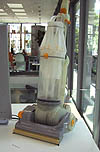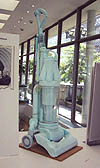|
In Three Parts...
--------------------------------------------
Page One -- Page Two -- Page Three
--------------------------------------------
"I'm always slightly suspicious of [ethnographic research]; I think in many ways, watching people is interesting, but you're not quite hearing what they're thinking while they're doing it."
C77: I'm wondering about some of the ethnographic research that you've done for the line of vacuum products...observing people, videotaping. Do you, or your team, get involved in that kind of research?
JD: Well, we've done a bit of that, yeah. To be honest--not very much, because one of the nice things about our product is that everybody uses it. And we have a lot of people around us at work, so you can get almost anybody to use anything and then make a judgment from that. We have done some ethnography. But I'm always slightly suspicious of it; I think in many ways, watching people is interesting, but you're not quite hearing what they're thinking while they're doing it.
C77: Similar to the problem in focus groups: if you ask someone what they think they want, they can't really tell you much more than that.
JD: Exactly--you rarely get quite the right answer. And I think I would always trust a designer's view on something, what a designer thought, and then challenge it with what's actually going on and what you observe in other people. And then come to the conclusion out of the two responses you're getting, rather than just taking video footage of people, watching it, jumping to a conclusion, and then acting on that conclusion. There's quite an interesting parallel there, I think, with market research. What market research tells you is never...well, is not always, quite right.
C77: Often I think it's sort of a closed deductive process, where you are getting what you are giving and nothing more.
JD: Yes, yes.
C77: Well, actually on that point, do you talk to people who have used your product--some sort of active feedback system? There are so many really wonderful ergonomic touches to the new vacuum--the two traps, the hose--I mean, the hose expands to 17 feet! That's an insane accomplishment, and a very, very desirable feature for the user. Did this come to you from the outside?
JD: Well, the hose is quite an interesting example. When I started developing the product way back in 1981 or '82, there wasn't a hose on the back of an upright vacuum cleaner. (There's an upright vacuum cleaner, and the canister version.) And it occurred to me, just designing it, why can't you have a hose on an upright vacuum cleaner? Now, the technical issue comes up right away: an upright vacuum cleaner blew the dust up into the bag...remember the old sort of sack on the back that puffed up when you turned the thing on? They were called "dirty fans," because the dirt went into the fan and then you blew it out. It's quite an efficient system, quite a good system.
C77: Maybe not so healthy for the fan...
JD: Well, the canister cleaners had what's called a "clean fan." You had the bag before the fan, but the fan was a much more efficient fan that went at much higher speeds--much more fragile, but more powerful and moved a lot more air. (In fact, the canister cleaner is essentially called a "suction cleaner.") So going back historically, an upright cleaner relied on the rotating brush to the lift and disturbed the dirt, and then the fan blew it up into the sack on the back.
Now, when I came to design the machine that would embody my cyclonic separation system, I looked at this issue of the motor, and thought, "why do I have to choose, as a consumer, between a canister cleaner and an upright cleaner?" As a designer, why couldn't I combine the two into one? So what I did--which is more complex than the existing upright system of blowing the dust up--is put a canister motor in an upright vacuum cleaner, giving it much stronger suction.
C77: You get the best of both worlds.
JD: Right. But it wasn't at a consumer's suggestion, I just thought it's silly, isn't it, that you can't suddenly whip off this attachment to suck all the edge bits, whereas you'd normally have to go and get out another cleaner to do that. And so we started making it. And I had to go and find someone to make a stretch hose, because they'd gone out of fashion. Curiously enough, this type of hose was the very first type of hose made, but then people got into plastic hoses. And so they stopped making the ones that expanded so well. So I managed to find someone who still had the equipment, and then they started making it for me. Now we've worked with them for years.
C77: And then you innovate from there...
JD: I think our first hose had a two-and-a-half-to-one stretch, and the latest ones have six-and-a-half-to-one stretch. So we developed it enormously.
C77: And obviously the volumes are there for this manufacturer?
JD: Huge, huge volumes now, because almost every upright vacuum cleaner in the world has the hose on the back!
"You've got a culture, almost a world culture, that encourages plagiarism."
C77: I don't know how comfortable you are talking about your experiences with intellectual property, but I know that a lot of industrial designers, and especially design students, are very, very interested in ownership.
JD: Yeah, they're quite right to be.
C77: Well, almost to the point of being paralyzed, to be honest with you.
JD: I can well understand that.
C77: Many design students are so worried, so reticent to show anything to anybody, that it sort of hurts their learning. But looking at your bagless vacuum devices, and the way that they subvert the typical manufacturer's "give 'em the razors and sell 'em the blades" approach, you must have ran head-first into intellectual property issues from the get-go. So maybe you can talk to me a little bit about that.
JD: Well, I can talk to you a lot about that. And I think designers are quite right to feel paralyzed by it as well. I think it's a very paralyzing thing. What you've got going on in the world, is that large manufacturers, multinationals, and even some small manufacturers, think it's fair game to copy someone's intellectual property. And in fact, antitrust laws--and to a certain extent, the Treaty of Rome --encourage that. And I think it's very, very rare that a patentee wins a patent lawsuit.
C77: And of course, the patent is only as powerful as the amount of money you have to defend it.
JD: Well, and what we're talking about is words, and descriptions, and it's a very finite thing. And it's very much weakened by what they call "prior art." Remember, the comptroller of the U.S. Patent Office, 1901, said that, "we might as well shut down the U.S. Patent Office because there's nothing left to invent." And actually he was right, in the sense that what happens now, as more and more patents are filed every year--so there's a sort of paradox here--the patents become narrower and narrower. And that's really the problem. Almost any patent nowadays is pretty narrow in its scope, which allows people to get very, very close to it. And of course, the patent defines how close you can get, which is also a lot of people's objections.
C77: Lawyers are always very ambitious in terms of trying to grab as much as they can with that first application, fighting to the death for it. And as you say, after that it's a matter of picking it apart piece by piece.
JD: But then, the worst thing is that the patent means nothing, because when you go to court, it's as though the patent didn't exist. The whole thing starts all over again and you have to prove your inventiveness. So it's a pretty depressing scene for an inventor. You've got a culture, almost a world culture, that encourages plagiarism, you've got courts that don't always support the patentee, and you've got this extraordinary situation where when someone copies you, you're going to court--not to say, "here's my patent, this person copied it"--you're going to court to start all over again, as though the patent didn't exist! And the onus is on you, as the owner of the patent, to prove inventiveness. And to prove that it was indeed you that did it.
C77: And for Dyson, you're in a global arena at this point. It's one thing to talk about the U.S. and Europe, but you sell all over the world. So the issue really is a moving target.
JD: Exactly. And then there's the other part of it, which is expense--and this is, I think, where the really anti-competitive point exists. A designer, or a design company, or even a small manufacturing business can't afford patents, because they're very expensive to apply for. And then they're very expensive to renew, so it's the renewal fees which I think are actually illegal. I think they're an infringement of the human right, because if you're an artist or an author, you own the copyright to your work of art. And as an inventor, your invention is a work of art, it's prior art. But if you don't pay, you lose it. I've taken two cases to the European Court of Human Rights to point this out, but it's been thrown out because they adjudged that patent renewal fees were reasonable, that it was reasonable to charge $3,000 per country per patent to renew your patents every year. I would like to charge enormous design fees to cover the cost of those cases!
C77: You've spent a lot of your career defending your intellectual property then?
JD: Well, no, and I don't think I could really claim to be an expert at it, I mean, we fought a case here, we just fought a long case in England and we have one or two other smaller cases going.
C77: And you prevailed in both?
JD: Yes. I got what I wanted, yes. But one more point I wanted to make about intellectual property concerns the amount its costs to pursue someone who's infringed...I mean, you're talking multimillion dollar lawsuits.
C77: Fighting armies of lawyers.
JD: Yes, and time. Often the infringing company can carry on infringing, hoping that they can wear you down, so that in the end you accept very little if there's a settlement. And in the meantime, they've taken huge commercial advantage of your invention. But that's one bitch I have about the patent system. The other point, which is, I think, a far more fundamental point, is this cultural, or political, issue we have: that it's okay to copy something, because that's competition, that's the marketplace. And I think it's theft, and I think that it's time it was regarded as theft and actually became a criminal matter. So I have huge sympathies for students and young designers--I've been through it. More...
Page One -- Page Two -- Page Three
|














|



![]()













